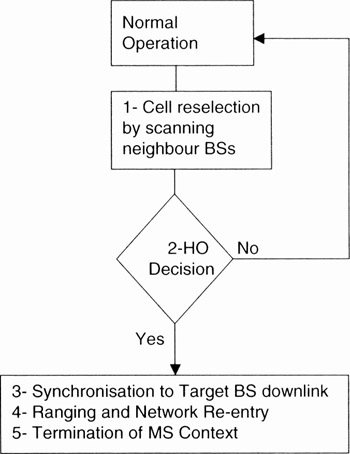14.3 The Handover Process
14.3 The Handover Process
The 802.16 standard states that the handover decision algorithm is beyond its scope. The WiMAX Forum documents do not select a handover algorithm either. Only the framework is defined. The MS, using its current information on the neighbour BS or after a request to obtain such information (see the previous section), evaluates its interest in a potential handover with a target BS. Once the handover decision is taken by either the serving BS or the MS, a notification is sent over the MOB_BSHO-REQ (BS Handover REQuest) or the MOB_MSHO-REQ (MS Handover REQuest) MAC management messages, depending on the handover decision maker: the BS or MS. The handover process steps are described in the following.
The handover process is made of five stages which are summarized in Figure 14.1. The HO process stages are described in the following sections [2].

Figure 14.1: Illustration of handover process stages. (Figure by B. Souhaid and L. Nuaymi.)
14.3.1 Cell Reselection
Cell reselection [2] refers to the process of an MS scanning and/or association with one or more BS in order to determine their suitability, along with other performance considerations, as a handover target. The MS may use neighbour BS information acquired from a decoded MOB_NBR-ADV message or may make a request to schedule scanning intervals or sleep intervals to scan, and possibly range, the neighbour BS for the purpose of evaluating the MS interest in the handover to a potential target BS.
14.3.2 Handover Decision and Initiation
A handover begins with a decision for an MS to make a handover from a serving BS to a target BS. The decision may originate either at the MS or the serving BS. The handover decision results in a notification of MS intent to make a handover thruugh the MOB_MSHO-REQ (MS HO REQuest) message (handover decision by the MS) or the MOB_BSHO-REQ (BS HO REQuest) message (handover decision by the BS).
The BS may transmit a MOB_BSHO-REQ message when it wants to initiate a handover. This request may be recommended or mandatory. In the case where it is mandatory, at least one recommended BS must be present in the MOB_BSHO-REQ message. If mandatory, the MS responds with the MOB_HO-IND message, indicating commitment to the handover unless the MS is unable to make the handover to any of the recommended BSs in the MOB_ BSHO-REQ message, in which case the MS may respond with the MOB_HO-IND message with proper parameters indicating HO reject. An MS receiving the MOB_BSHO-REQ messsage may scan recommended neighbour BSs in this message.
In the case of an MS initiated handover, the BS transmits an MOB_BSHO-RSP message upon reception of the MOB_MSHO-REQ message.
14.3.3 Synchronisation to a Target BS Downlink
Synchronisation to a target BS downlink must be done. If the MS had previously received a MOB_NBR-ADV (MAC management) message including a target BSID, physical frequency, DCD and UCD, this process may be shortened. If the target BS had previously received hanndover notification from a serving BS over the backbone, then the target BS may allocate a non-contention-based initial ranging opportunity.
14.3.4 Ranging and Network Re-entry
The MS and the target BS must conduct handover ranging. Network re-entry proceeds from the initial ranging step in the Network Entry process (see Chapter 11): negotiate basic capabilities, PKM authentication phase, TEK establishment phase, registration (the BS may send an unsolicited REG-RSP message with updated capabilities information or skip the REG-RSP message when there is no TLV information to be updated) and the other following Network Entry optional steps (lP connectivity, etc.).
Network re-entry may be shortened by target BS possession of MS information obtained from the serving BS over the backbone network. Depending on the amount of that information, the target BS may decide to skip one or several of the Network Entry steps (Figure 14.2). Handover ranging can then be a simplified version of initial ranging. To notify an MS seeking handover of possible omission of re-entry process management messages during the current handover attempt (due to the availability of MS service and operational context information obtained over the backbone network), the target BS must place, in the RNG-RSP message, an HO Process Optimisation TLV indicating which re-entry management messages may be omitted. The MS completes the processing of all indicated messages before entering Normal Operation with the target BS.

Figure 14.2: Summary of network re-entry steps
Regardless of having received MS information from a serving BS, the target BS may request MS information from the backbone network.
14.3.5 Termination of MS Context
This is the final step of a handover. Termination of the MS context is defined as the serving BS termination of the context of all connections belonging to the MS and the discarding of the context associated with them, i.e. information in queues, ARQ state machine, counters. timers, header suppression information. etc. This is accomplished by sending the MOB__HO-IND message with the HO_IND_type value indicating a serving BS release.
14.3.6 Handover Cancellation
An MS may cancel HO at any time prior to expiration of the Resource_Retain_Time interval after transmission of the MOB_HO-IND message. Resource_Retain_Time is one of the parameters exchanged during the registration procedure (part of Network Entry). The standard [2] indicates that Resource_Retain_Time is a multiple of 100 milliseconds and that 200 milliseconds is recommended as default.
EAN: 2147483647
Pages: 124